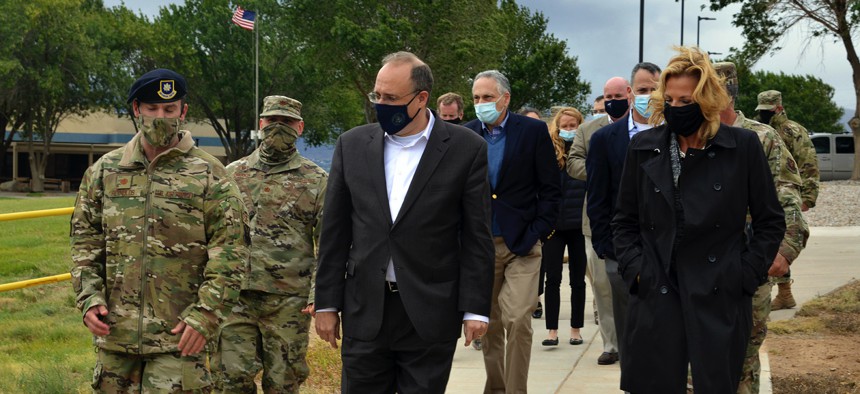
Todd R. Berenger/U.S. Air Force, via AP Marshall Billingslea, special presidential envoy for arms control, and NNSA Administrator Lisa Gordon-Hagerty, right, walk with Air Force personnel at Kirtland Air Force Base in Albuquerque, N.M.
To Reboot Arms Control, Start with Small Steps
Stop accusing. Set aside questions of structure. Start talking.
After generations of careful and painstaking work to build a global arms control architecture, it is now collapsing. The New Strategic Arms Reduction Treaty, or New START, is the last legally binding treaty constraining the world’s two largest nuclear arsenals and unless extended, it will expire in less than six months. At the same time, nuclear stockpiles are on the rise, which can lead to a new nuclear arms race, putting every nation on this planet in danger. The situation is dire, but not inevitable or irreversible. Starting with an extension of New START and moving to constructive and fair dialogues on reducing nuclear risks, we can change our collective fate.
There are three guiding principles that can help make future arms control dialogues more successful. First, the focus should be on substance rather than format. Currently, the reverse is true. The United States is pushing for a trilateral framework with Russia and China; China would like to bring in the United Kingdom and France; and Russia is fine with both options, but believes that in the short term only a bilateral format is realistic. It is not necessary to agree on a single format for dialogue. Addressing concrete security concerns should be the priority and the format should be adapted to the substantive issues at hand. Negotiation over strategic offensive weapons could – for the time being – still be limited to the United States and Russia. Discussing issues of missile defense or space security may make sense for a trilateral discussion because Washington, Moscow, and Beijing are the most relevant players. And talks about security challenges from new technologies can be a broader discussion as there are more stakeholders.
Second, new structures will be needed to address the capability asymmetry among the major powers. The U.S. and Russian nuclear arsenals are substantially larger than China’s, but China has a numerical advantage in land-based conventional missiles. Future arms control agreements could be shaped to include both nuclear and nonnuclear strategic capabilities into an integrated framework. Innovative arms control models like this will be necessary to help countries address their unique security concerns.
Third, countries need to stop talking about each other and start talking to each other. Instead of pragmatic engagement, the major powers have been busy issuing coercive threats and blaming the other parties for lack of progress. There is enough bad blood already among Washington, Moscow, and Beijing, and the ongoing propaganda war among these capitals is totally counterproductive to reducing nuclear risks. In managing this problem, Germany can play an important role. As a respected partner of all these countries, Berlin can act as a trusted convener, organizing expert-level talks and inviting representatives from the major powers to examine and debate concrete arms control ideas. These dialogues can then lead to actions.
There are also a few specific measures that can and should be taken immediately.
Any future negotiations will require dedicated and competent professionals to support the process. With no formal talks over the past decade, Russia and the United States will likely need to recruit and train more diplomats, technical experts, scientists, and lawyers to staff their delegations. This would be even more critical for the countries with less experience in arms control diplomacy.
Nuclear powers should also take steps to preclude the kinds of misunderstandings that can lead to conflict. That means enhancing investments in transparency and crisis communications. The United States and Russia have a long-established “hotline” allowing for secure and quick exchanges. A similar, but less developed, hotline exists between the United States and China. Moscow and Washington also exchange information on ballistic missile launches. Moscow and Beijing do the same. There is no reason such communications and procedures should not be established among the five nuclear weapons states recognized under the Treaty on the Non-Proliferation of Nuclear Weapons. The existing dialogue among the five permanent members of the UN Security Council could be a good place to begin the process of creating such multilateral tools.
Finally, all nuclear powers should reaffirm their commitment to the global moratorium against explosive nuclear tests. Further, ratification of the Comprehensive Nuclear-Test-Ban Treaty by the United States and China is long overdue. In the early 2000s, Moscow hinted it was ready to discuss more stringent verification measures to help monitor compliance with the treaty. A renewed discussion on the matter could finally help move the critical agreement towards entry into force.
75 years after the dawn of the nuclear age, the world is at a crossroads. One path is towards the mistakes of our past—mistakes we were lucky to survive the first time. The other path can lead toward cooperation and increased stability. While the right choice should be clear for leaders in Washington, Moscow, and Beijing, they can all use some encouragement.
The authors are part of the Körber Strategic Stability Initiative, a joint project on the future of arms control by Körber-Stiftung and the Institute for Peace Research and Security Policy at the University of Hamburg.



